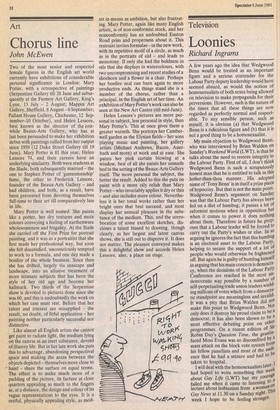Art
Chorus line
John McEwen
Two of the most senior and respected female figures in the English art world currently have exhibitions of considerable personal significance in London: Mary Potter, with a retrospective of paintings (Serpentine Gallery till 28 June and subse quently at the Fermoy Art Gallery, King's Lynn, 13 July — 2 August; Mappin Art Gallery, Sheffield, 8 August —6 September; Pallant House Gallery, Chichester, 12 September-10 October), and Helen Lessore, best known as the director of the erst while Beaux-Arts Gallery, who has at last been persuaded to make her exhibition debut with paintings culled from her output since 1959 (12 Duke Street Gallery till 19 June). Mary Potter is 81 this year, Helen Lessore 74, and their careers have an underlying similarity. Both were students at the Slade, both subsequently married — the one to Stephen Potter of 'gamesmanship' fame, the other to Frederick Lessore, founder of the Beaux-Arts Gallery — and had children, and both, as a result, have been prevented from devoting themselves full-time to their art till comparatively late in life.
Mary Potter is well named. She paints like a potter, her dry textures and mute colours conveying a feeling of earthenware wholesomeness and frugality. At the Slade she carried off the First Prize for portrait painting, and it was as a portraitist that she first made her professional way, but soon she felt dissatisfied, unconsciously tempted to work to a formula, and one day made a bonfire of the whole business. Since then she has drifted, largely via seascape and landscape, into an allusive treatment of more intimate subjects that has been the style of her old age and become her hallmark. Two thirds of the Serpentine show is devoted to pictures done since she was 60, and this is undoubtedly the work on which her case must rest. Before that her talent and interest are misapplied — the result, no doubt, of fitful application — her painting neither particularly successful nor distinctive.
Like almost all English artists she cannot get paint to radiate light, the medium lying on the canvas as an inert substance, devoid of illusory life. But in her late work she puts this to advantage, abandoning perspectival space and making the areas between the objects depicted — themselves more close to hand — share the surface on equal terms. The effect is to make much more of a pudding of the picture, its facture at close quarters appealing as much to the fingers as, at a distance, the design and colour of its vague representations to the eyes. It is a restful, physically appealing style, as mod est in means as ambition, but also frustrating. Mary Potter, again like many English artists, is of non-conformist stock, and her nonconformity has an undoubted Euston Road prim and properness about it. This restraint invites formulae —in the new work, with its repetitive motif of a circle, as much as in the portraits of old — and leads to monotony. If only she had the boldness in oils that she displays in watercolours, with two uncompromising and recent studies of a shoehorn and a flower in a chair. Perhaps her bonfire zeal can burn again to more productive ends. As things stand she is a member of the chorus, rather than a principal, in the English art of her time. An exhibition of Mary Potter's work can also be seen at the New Art Centre (till mid-June).
Helen Lessore's pictures are more personal in subject, less personal in style, than Mary Potter's. This at once gives them a greater warmth. She portrays her Camberwell garden as the Elysian fields — her sons playing music and painting, her gallery artists (Michael Andrews, Bacon, Auerbach and more) at work and at ease. She paints her pink curtain blowing at a window, best of all she paints her unmade bed in the setting of the Beaux-Arts Gallery itself. The more personal the subject, the better the result. Added to this she puts on paint with a more oily relish than Mary Potter who invariably applies it dry or thin — and also includes more colour. Nevertheless it is her tonal works rather than her bright ones that best succeed, and most display her sensual pleasure in the substance of the medium. This, and the corroboration of some excellent sketches, discloses a talent biased to drawing, though clearly, as her largest and latest canvas shows, she is still out to disprove it. It does not matter. The pleasure conveyed makes this a delightful show and accords Helen Lessore, also, a place on stage.










































 Previous page
Previous page